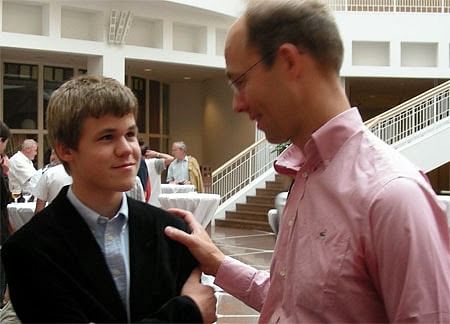
Magnus Carlsen vs Vishy Anand: Road to Chennai 2013 - Early development

What did it take for a Norwegian to reach a match for the World Championship title? In addition to a talent for and deep interest in chess, I think it was important to get possibilities and encouragement on the way. Support from family, friends, trainers and sponsors are helpful in providing the necessary possibilities.
Encouragement came through results and also support from various people. During the Norwegian youth team championship in 2000, a strong junior player was asked for the result by a friend after one of the rounds, and he responded with self deprecating irony something like: “Well, I played a 9-yr old as white and was a piece up by move 5…”. His friend had drawn his conclusions by the time he added: “And I lost”. Magnus’s piece sacrifice was not theoretically correct but highly enjoyable for the spectators and certainly encouraging for people around him.
For Magnus personally, the last round draw against the strongest Norwegian U16 player Tallaksen was maybe even more gratifying. By this time Magnus had already had a couple of valuable sessions each month for half a year with Torbjorn Ringdal Hansen (Simen Agdestein’s assistant) at the Top Athletes School Chess group. In Norway children participation in sports competitions is restricted in general.
A sponsoring agreement has been agreed between Arctic Securities and Magnus Carlsen. Magnus became an International Grandmaster at the age of 13, the youngest at the time. In October 2009, during the Nanjing Pearl Spring tournament, he became the fifth chess player in the history to achieve an Elo-rating over 2800 – by far the youngest to do so. That year he also became The World Blitz Chess Champion. On January the 1st of 2010 the new FIDE list was published and at the age of 19 Magnus became the youngest ever chess player to be ranked World Number One. Carlsen is the best representative for top excellence within both analysis and implementation.
In chess the practices have varied, and when Magnus was 11 back in 2002 he was allowed to participate in the European and World Youth U12. This represented a first opportunity to fight with the best peers in the world (except for Karjakin who was already a GM and did not participate any longer). In the European U12 Championship the Russian child stars Nepomniachtchi and Andreikin dominated as usual, while in the World Youth U12 Magnus was already catching up and came 2nd on tiebreak after the winner Ian Nepomniachtchi.
By this time, Simen Agdestein himself had already been the trainer of Magnus for about a year, and a little later Computas became his first sponsor for 6 months. In January 2003 another event was staged by Hans Olav Lahlum at the traditional chess site of Gausdal amidst inspiring mountains with downhill and cross country skiing tracks.
Magnus needed a last round win against his somewhat older adversary and friend IM Bluvshtein from Canada, and surprised many by achieving the necessary victory after a good game and a hard fight. The international break-through securing a GM-norm and winning the Corus C-group in 2004 is well known to many, and less emphasis is put on the huge number of tournaments Magnus played in the autumn of 2003 during a family sabbatical year, that prepared him for the progress seen in 2004.
By this time, Microsoft Norway was sponsoring Magnus and facilitating his participation in tournaments every month. Prior to our sabbatical, Simen Agdestein and other Norwegians had been very optimistic about the prospects of Magnus as a chess player, and during the 1st half of 2004 a number of strong players and international chess journalists showered praise on the young Norwegian providing encouragement for both Magnus himself and people around him.